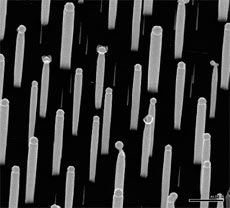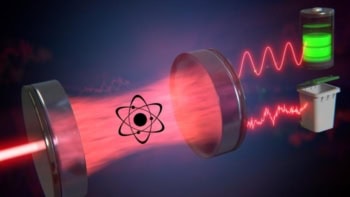
Understanding how materials behave at tiny length scales is crucial for developing future nanotechnologies and continues to be a great challenge for both theoretical and experimental physicists alike. Now, a physicist at the Institute of Electronics, Microelectronics and Nanotechnology (IEMN) in Villeneuve d’Ascq, France, has borrowed from 19th century physics to come up with a new “universal” equation that predicts how size affects the key physical properties of nanometre-sized structures, which behave very differently from their macroscopic counterparts.
The surface-to-volume ratio of a structure increases dramatically as it is made smaller and therefore surface effects can be very important for tiny devices. “My equation links size effects not only to this surface-to-volume ratio but also to the intrinsic nature of the particles involved in the considered material property – that is, whether they are fermions or bosons,” Grégory Guisbiers told physicsworld.com.
Four temperatures
Guisbiers developed his equation by analysing and comparing how the size of nanoparticles affects the temperature at which they melt, become superconductors and become ferromagnetic (Curie temperature). He also considered the Debye temperature, which is related to how lattice vibrations conduct heat in a material. These four “characteristic” temperatures are key physical quantities for any material and all are inter-related: the melting temperature is proportional to the Curie temperature, to the square of the Debye temperature and to the square of the superconducting temperature.
The equation (TX/TX,∞ = [1–αshape/D](1/2S)) is based on the diameter of the nanostructure (D); a parameter (αshape) that is related to the surface-to-volume ratio; and the spin (S) of the particles involved in the considered material property. S equals 1/2 or 1 depending on whether the particles are fermions (particles with half-integer spin) or bosons (particles with integer spin). TX stands for melting, Debye, Curie or superconducting temperature and TX,∞ is that temperature in a macroscopic sample of the material. The equation has no adjustable parameters and works for all materials, says Guisbiers. In general, the characteristic temperatures decrease as particles become smaller.
Melting and ferromagnetism (which obey Fermi–Dirac statistics laws) are different from superconductivity and lattice vibrations (which follow Bose–Einstein statistics). This difference in behaviour is intimately related to the spin of the particles involved: melting is a solid-liquid phase transition and it occurs when inter-atomic bonds thermally break and a broken bond results in unpaired electrons, each characterized by a half-integer spin. Ferromagnetism, in turn, is a net magnetic moment that appears in the absence of an external magnetic field, and occurs thanks to partially filled shells of electrons. It is again characterized by a half-integer spin.
Putting the right spin on it
Lattice vibrations are described by phonons, which, on the other hand, have integer spin. Superconductivity is a state in which conduction electrons are ordered into pairs of electrons, called Cooper pairs, also characterized by integer spin.
Predictions obtained from the equation agree very well with experimental data on melting and superconducting behaviour of nanoparticles – of silicon or lead, for example. The theory agrees fairly well with experimental results for ferromagnetism and lattice vibrations – the discrepancy is less than 10%. “This is an acceptable value because the model is quite simple and only requires knowledge of the size, shape and spin situation of the particles involved,” adds Guisbiers.
“The work shows that 19th century physics can still provide useful insights into 21st century nanotechnology, and all this can be done with just a pencil and paper – no supercomputers involved!”
The work is described in Physics Letters A.



